It’s been two years since Gore announced the retirement of its Gore-Tex Shakedry technology. This was ahead of the US state-by-state ban on the environmentally harmful PFAS (polyfluoroalkyl) particle, soon to be adopted by the European Union.
Shockwaves have been felt in the cycling industry ever since, as it wasn’t just the iconic Shakedry jacket that incorporated chemicals. Almost all fabrics are used for construction best waterproof cycling jackets use these chemicals. Brands had to start over.
The main reason for this whole cycle of change was the fear that all our wet weather mechanisms would become worse at keeping us dry.
We caught up with a number of cycling apparel brands to find out how they’ve adapted and tackled the challenge of becoming PFAS-free, and what that means for your favorite cycling rain jacket.
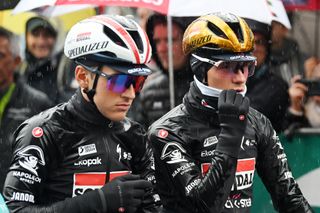
Belgium’s Remko Evenepoel and Team Soudal Quick-Step wearing Castelli rain jackets in the rain ahead of the 103rd Tre Valli Varese 2024
(Image credit: Getty Images)
Castelli
Castelli has been hit hard by the ban on PFAS, its icon Gabba One of the first to feel the consequences of the US ban. Castelli quickly returned with the redesigned Gabba R.
Castelli Global Brand Manager and half-inventor of the original Gabba explained Steve Smith: “If you ask me. [about the legislation] even six months ago I would have been really negative.
“The brand explored a number of ‘non-conductive membranes,'” he said, but these simply dampened the inside of the driver.
The latest racing content, interviews, features, reviews and expert buying guides straight to your inbox!
“A lot of fabric suppliers were going down this road, everyone was thinking about waterproofing, but not about breathability,” he admits, confirming that this led to the break-up of a long-standing partnership with Gore-Tex fabrics.
“For some reason, the industry has taken a somewhat ridiculous measure of what can be designated as water-resistant,” Smith says, explaining that it has historically been tested against 10,000 mm of water column, or 10 m of water pressure. “If you’ve ever dived 10m, you know what that kind of pressure feels like,” he says, adding that the standard is designed so you can sit in a pool of water with your full body weight.
“On a bike, we don’t really have that level of pressure against the water,” Smith tells me, explaining that normal rain equates to about 800mm of water column, add the rider’s speed, and according to Smith, the Cyclist will remain effectively waterproof even in 2000mm of water column.
Before confirming that Castelli’s newer Gabba R products have been tested up to 5000mm, Smith said: “Once again we have a ‘standard’ made to sell over-engineered fabrics that go beyond what we really need and sacrifice breathability in the process ” he said. water column.
“We still have waterproof shells,” he explains, noting that waterproofing hasn’t been taken off the table, but you’ll be drier and more comfortable all day in something more breathable.
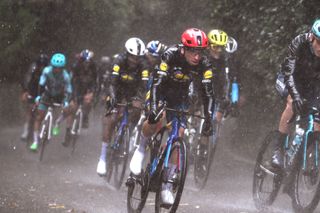
(Image credit: Getty Images)
Santini
Breach of cycling rainwear technology
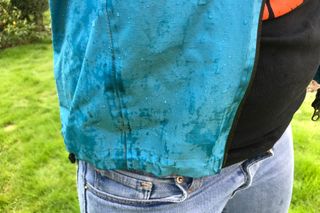
(Image credit: Rachel Sokal)
Most waterproof jackets are a sandwich of three layers: a durable water repellent (DWR)-treated exterior that noticeably seals out water when repelled, a breathable waterproof membrane in the middle, and a softer touch next to the skin. Gore-Tex Shakedry eliminated the outer layer, exposing the PFAS-containing ePTFE membrane, and did not need a DWR coating. This is what makes it light, waterproof and breathable and comfortable because it never needs to be reproduced. The challenge now is to recreate this without using PFAS chemicals.
As a brand that has not used Gore-Tex fabrics since 2017, Santini, which chose to work with fabric house Polartec, said it was ready to phase out PFAS fabric sooner than some cycling apparel brands.
Santini Creative Director Fergus Niland says, “The fabric has to work harder as a person sweats, and a cyclist reaches this point faster than a hiker in the woods.”
“A critical metric [in cycling] It’s air exchange from the inside out to stop you getting wet,” he added, “and it’s this internal sweat build-up that’s responsible for keeping you cold when you’re wet,” he adds, explaining the challenges behind creating a breathable waterproof membrane.
Made from Bio-nylon with 48 percent plant-based ingredients, which Polartec says is PFAS-free, the Polartec Power Shield Pro fabric used by Santini for many of its top water-repellent jackets reverts to a three-layer membrane system, while Niland is PFAS-free over time. Confirms that DWR will require redoing.
Last week, Santini introduced the Magic rain jacket, one of the first garments to use the new Polartec Power Shield RPM fabric, which is extremely light, flexible, packable and highly breathable. The fabric is made from eco-friendly, recycled polyester.

Michael Storer, Tudor Pro Cycling Team, Stage 17, Team ASSOS rain jacket at Giro d’Italia 2024
(Image credit: Getty Images)
Assoc
What is PFAS?
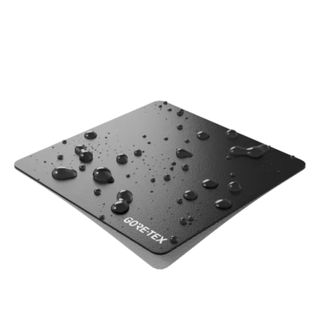
(Image credit: GORE)
Polyfluoroalkyl substances (PFAS), known as “forever chemicals”, are not only used in cycling kit. Found in various foams, pacemakers, non-stick cookware and thousands of everyday products, PFAS is resistant to heat, oil, grease and, most importantly, water for cycling. The problem is that they don’t dissipate, they find their way into water systems, soil and us. It has been linked by scientists, including chemicals United States Environmental Protection Agency and European Environment Agencyto serious health and environmental problems.
An exception to the PFAS-free rotation is Assos. The brand’s Chief Development Manager Luca Zanasca and Textile Specialist Claudio Lanfrancon confirmed that it is only starting to release fabrics from its collections, will see the first changes in the summer of 2025, and the brand hopes to be PFAS-free by autumn. /Winter of 2025/ 26.
Asking the pair more about the expected performance of these new arrivals, Lanfrancon explains that “it won’t be a very noticeable difference for the driver”, adding that users may experience a little less water resistance.
“We have big changes planned for 25/26,” Zanasca lets slip. “The performance of winter clothing will remain the same, but the accessories will avoid waterproofing.”
Inquiring further from Zanasca, he tells me that most of the focus will be on the brand’s best-selling Mille GTS. [Wasserschnause] Rain jacket S11. “The new version will improve on the last iteration, with similar waterproofing but improved breathability,” he said, concluding that “it’s not just about the manufacturing of the rain jacket, but its application and fit are just as important.”

The Altura NightVision Storm rain jacket is a favorite among commuter cyclists in the UK
(Image credit: Altura)
Altura
British brand Altura, which only caters to UK drivers, is not required by any US or EU PFAS legislation. However, Ian Young, head of Own Brand, was keen to point out that Altura is still working to keep the fabrics free of eternal chemicals, saying: “It’s the right thing to do, especially for a brand that works directly with the outdoors.”
Young says the popular Altura Night Vision line is nearly PFAS-free, but older stock is still in circulation.
Young confirmed that when comparing the old PFAS-based fabric in the Night Vision line to the new version, the water resistance won’t last as long.
“The new fabrics require you to wash and re-wash more often. It’s not going to last out of the box. You’re just going to have to pay a little more attention to them,” Yang clarifies.
“If anything, the new pieces will be better,” he adds optimistically. “They will be stronger and more durable than the old Gore-Tex Shakedry [ePFE), which had a lot of usage restrictions, such as the risk of damage when using a rucksack or riding off-road.”

The Women’s Cinder Kinetic Waterproof Biking Jacket
(Image credit: RAB)
RAB
Rab (Equip Deutschland GmbH group) has very much led the charge on PFAS-Free fabrics, as early adopters of the Gore ePE (PFAS-Free) fabrics.
Cycling Weekly has already covered the brand’s move to providing Material Facts transparent data sheets for every piece of RAB apparel, and its road map to becoming completely PFAS-free can be found on the Rab website.
Equip Deutschland GmbH PR and Communications Manager for Europe, Sarah Kampf, informed me that the brand is now focusing on educating consumers who have “become very used to the performance of older PFAS waterproof fabric”.
“The newer solutions perform differently and have a different look and feel when wet,” admits Kampf, adding that fabrics now have to be treated and cared for differently after purchase, which she believes is the biggest challenge going forward.

The AlpKit Arro shell rain jacket
(Image credit: AlpKit)
AlpKit
Award-winning independent outdoor brand AlpKit has gained a loyal following of UK customers who buy into the brand’s ethical ethos.
Head of Clothing Ronnie Legg told me that the brand started moving away from PFAS-based DWRs more than five years ago, although, surprisingly the brand isn’t yet PFAS-free.
Legg says the challenges are often due to limits with supply-chain options on small amounts of fabric where sources of PFAS can cross-contaminate garments, such as the oil in sewing machines.
According to Legg, PFAS-free DWR fabrics are an imperfect solution. “It’s not that it doesn’t repel water as well [compared to PFAS), but that it doesn’t repel oil,” he says, explaining that dirt and contaminates can prevent the water-repellent effect, and will happen much quicker with PFAS-free DWR compared to the older formulations.
Legg reiterates the importance of customers doing more aftercare, washing, and re-proofing, which adding to customer demands for lighter-weight fabrics with higher levels of breathability, will mean a compromise on durability
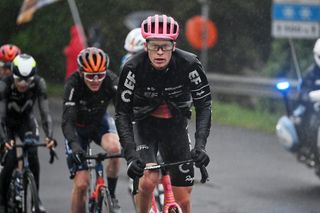
Georg Steinhauser of Team EF Education – EasyPost in the Rapha rain jacket at the 20224 Tre Valli Varesine
(Image credit: Alamy)
Rapha
With Gore as a main fabric partner, Rapha was in a similar boat to Castelli when having to re-consider life without old PFAS-based fabrics. However, Rapha remained loyal to the brand and has just announced a new Rapha Gore-Text rain jacket.
Using the same new ePTE [PFAS-free] A Gore-Tex fabric like the Gore Wear SpinShift rain jacket (see below), the rain jacket was released with much fanfare and fanfare, boasting that it was completely windproof, reliably breathable and durable waterproof.
Claiming the fabric’s first performance wear use, Rapha says the three-layer membrane is as thin as possible and guaranteed to keep you dry.
What isn’t guaranteed is that it’s actually PFAS-free, which is an interesting small print arrow hiding under the big headlines.

The new GoreWear SpinShift cycling rain jacket
(Image credit: GOREWEAR)
Gorewear
As a fabric house and clothing brand, Gore and Gorewear are doing a double-take when it comes to moving away from perpetual chemicals in their range, along with a whole new fabric engineering to make it rainwear. Quietly announcing the gradual retirement of groundbreaking work Shocking jacket and fabric two years ago, Gore had actually been working on a replacement for Gore-Tex ePE fabrics for quite some time.
Released in 2021, the expanded PFAS-free Polyethylene (ePE) fabric is super-thin and lightweight, while providing the same level of “durability and durable water resistance,” according to Christian Mayer, Product Specialist at GoreWare.
Launched earlier this year with the SpinShift GTX jacket made using the new fabric, the brand took the opportunity to increase the use of sustainable textiles by including a recycled face textile and a recycled and dyed backing.
Michael Jean-Jacques Production Line Manager Gorewear explains the challenges of ensuring a sport-specific fit and minimizing bulk from waterproof taped seams. Despite the move to a three-layer membrane, Gorewear tells me there’s only a 37-gram increase when comparing its C5 GTX SD 1985 Jacket and the new Spinshift GTX Jacket (both Large).
What does this mean for me?
It seems the old days of never-ending water beads are over, and as many brands say, it’s now up to us consumers to play our part in adapting to the “new normal.” lifetime raincoat performance expectations.
The big take-home message for riders is that aftercare will be key to the longevity of the performance of your future, or existing, PFAS-free cycling rain jacket.
We tried to clarify how to do it Make your cycling gear waterproof again Using (eco-friendly) DWR treatments will help take some of the hassle out of sticking a jacket in the washing machine, which is usually very expensive.


